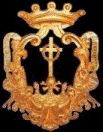| Arciconfraternita del Sacro Monte dei Morti in S. Giustino - Chieti |



A brief history of the Procession
The Good Friday Procession in Chieti has very ancient origins (according to some historians,
beginning in the year 842, so being the oldest one in Italy). It has maintained across the time
a relevant ritual solemnity and an intense spiritual fervour, thus becoming across the centuries one
of the most significant religious expressions of Easter in Italy.
From historical documented sources, the origins of the Procession in its current form date back to
the 16th century, as well as the foundation of the "Arciconfraternita del Monte dei Morti" (Mount of
the Dead Brotherhood), which was created upon the model of the homonymous "Confraternita dell'Orazione
e Morte di Roma" (Roman Brotherhood of Prayer and Death), to which for a certain time the Brotherhood
of Chieti was joined, before its formal institution which took place in 1603. This happened thanks to
the initiative of the Captain of the local army Pietro Antonio Gigante, to whom the Church authority
of the time granted, as its official seat, the current Chapel annexed to the crypt of St. Giustino
Cathedral, that is still today the seat of the Brotherhood.
Among the scopes of the first Death Brotherhood there were those of providing for the burial of bodies
scattered in the countryside because of wars and pestilence, and other charity activities, such as the
preparation of the Good Friday. From the archives of the local diocese, we can find the documented
participation of the members of the Brotherhood to the Jubilee of the year 1650, which was done in
Rome at the presence of Pope Innocence X, who received the pilgrims and granted the Brotherhood
members certain privileges and indulgences too.
The Good Friday Procession of Chieti, in its most simple forms dates back to the beginning of the 17th
century. It was founded on three dominant symbols: a wodden Death, a black damask Banner and a
Catafalque on which the Dead Christ was laid. Those three symbols where taken by the Brethren with
the ritual hood and sack clothes.
In the first decades of the 18th century the Chorus of Musicians started to join the Procession.
Until the first half of the 19th century, the Procession was done in the morning of the Good Friday.
At that time, not being the electricity on the streets yet, candles and torches were used to light
up the windows and the balconies that were along the way.
It was in that period that the lamps were used for the first time (and still are used). They were
located on top of long wood poles held by the members of the various congregations, made by different
shapes for each Congregation.
In 1965 along the way of the Procession iron handcrafted tripods were placed, which are still used,
on top of which the torches were set. In 1855 the "Trofei della Passione" (Symbols of the Passion)
were introduced, which precede the images of the Christ and the Virgin Mary. The Symbols were created
by the sculptor Raffaele Del Ponte from Chieti, who was a pupil of the famous Neapolitan sculptor
Antonio Nicolini, a scene-painter of the San Carlo Theatre in Naples. The statue of Our Lady of
Sorrows appeared for the first time in 1833, and the one you can admire today dates back to 1910.
The Dead Christ is a work of art, made in polychrome wood, which dates back to the 18th century,
and it is laid down on a pall of black velvet richly embroidered, that was realized in 1930 by using
old ancient embroideries in gold and silver, restored and transferred on the new cloth.
The Procession was always celebrated, even during the war, though in a reduced form. In case of bad
weather or snow, the rite has been always celebrated regularly. The Procession held in 1944 was a
memorable one, when the German troops tried to round up all the men who took part into it.
Fortunately almost all of them were able to save themselves through the hidden exit of the Cathedral.
Arciconfraternita - Chieti 2008 © All rights reserved |
